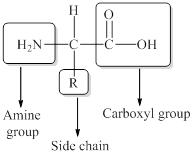
Concept explainers
Interpretation:
The amino acids in the given hexapeptide should be identified.
Concept introduction:
Amino acids are the molecules containing an
Carbon, hydrogen, oxygen and nitrogen are the key elements in amino acid.
General structure of an amino acid can be drawn as follows,

The amino acids are distinguished from one another by their R group also known as a side chain.
Some amino acids are listed below,
Peptide is a short
Peptide bonds are formed by a condensation reaction of carboxylic group of an amino acid and amino group of another amino acid with the removal of water molecule.
Want to see the full answer?
Check out a sample textbook solution
Chapter 23 Solutions
General Chemistry: Atoms First
- Which of the following are true concerning the chemical bond that forms between the carboxyl (RCOOH) group of one amino acid and the amino (RCNH2) group of another? a.The bond is called a peptide bond. b.It is formed by inserting a water molecule between them. c.It is formed by a dehydration reaction. d.A polypeptide has more of these bonds than a protein.arrow_forwardTo which family of mirror-image isomers do nearly all naturally occurring amino acids belong?arrow_forwardIn what way is the structure of glycine different from that of the other 19 common amino acids?arrow_forward
- What special role does the amino acid cysteine have in the peptides vasopressin and oxytocin?arrow_forwardFor the tripeptide SerArgIle which amino acid residues a. are hydrophilic b. are hydrophobic c. possess polar neutral R groups d. participate in two amide linkagesarrow_forward(a) How many tripeptides can be made from glycine, alanine, and leucine, using each amino acid only once per tripeptide? (b) Write the structural formulas of these tripeptides and name them in the shorthand abbreviation used for showing amino acid sequences.arrow_forward
- What functional groups are found in all amino acids? How many different amino acids are found in naturally occurring proteins?arrow_forwardFor the tripeptide AlaValGly which amino acid residues, if any, a. are hydrophilic b. are hydrophobic c. possess nonpolar R groups d. participate in two amide linkagesarrow_forwardFill in the blanks in the following statements: aThe order of the amino acids in a protein is the ______ structure of that protein. The _______ of the backbone chain of a protein is the secondary structure of that protein. The tertiary structure of a protein describes the ______ of the secondary structure. b Hydrogen bonding between the oxygen atoms of carbonyl groups and the hydrogen atoms of amide groups in the same protein chain gives the secondary structure, called the ______. c Hydrogen bonding between the oxygen atoms of carbonyl groups and the hydrogen atoms of amide groups in the adjacent protein chain gives the secondary structure, called the ______.arrow_forward
- Give an example of amino acids that could give rise to the interactions pictured in Fig. 21-24 that maintain the tertiary structures of proteins.arrow_forwardDo the amino acid sequences: valine-asparagine and asparagine-valine represent the same compound? Explain.arrow_forward22-62 Distinguish between intermolecular and intramolecular hydrogen bonding between backbone groups. Where in protein structures do you find one, and where do you find the other?arrow_forward

 Living By Chemistry: First Edition TextbookChemistryISBN:9781559539418Author:Angelica StacyPublisher:MAC HIGHER
Living By Chemistry: First Edition TextbookChemistryISBN:9781559539418Author:Angelica StacyPublisher:MAC HIGHER Chemistry: The Molecular ScienceChemistryISBN:9781285199047Author:John W. Moore, Conrad L. StanitskiPublisher:Cengage Learning
Chemistry: The Molecular ScienceChemistryISBN:9781285199047Author:John W. Moore, Conrad L. StanitskiPublisher:Cengage Learning World of ChemistryChemistryISBN:9780618562763Author:Steven S. ZumdahlPublisher:Houghton Mifflin College Div
World of ChemistryChemistryISBN:9780618562763Author:Steven S. ZumdahlPublisher:Houghton Mifflin College Div General, Organic, and Biological ChemistryChemistryISBN:9781285853918Author:H. Stephen StokerPublisher:Cengage Learning
General, Organic, and Biological ChemistryChemistryISBN:9781285853918Author:H. Stephen StokerPublisher:Cengage Learning Organic And Biological ChemistryChemistryISBN:9781305081079Author:STOKER, H. Stephen (howard Stephen)Publisher:Cengage Learning,
Organic And Biological ChemistryChemistryISBN:9781305081079Author:STOKER, H. Stephen (howard Stephen)Publisher:Cengage Learning,





